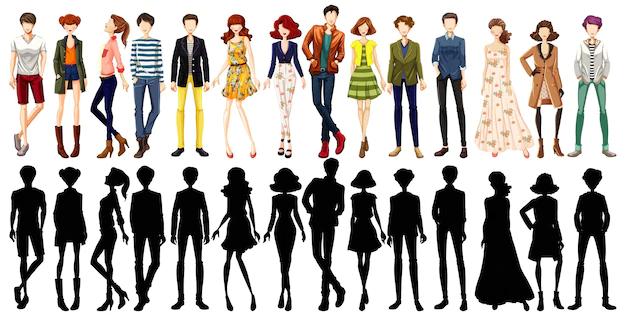Flattering Swimsuits: A Comprehensive Guide to Achieving the Perfect Silhouette
The selection of swimwear significantly impacts an individual's comfort and confidence levels, particularly during summer activities. This guide provides a structured approach to swimsuit selection, incorporating principles of body shape analysis, color psychology, and principles of effective visual communication to assist in creating a flattering and empowering swimwear choice. This comprehensive analysis offers fifteen key considerations to ensure a positive and confident swimwear experience.
Body Shape Analysis: The Foundation of Swimsuit Selection
Effective swimsuit selection begins with a thorough understanding of body proportions, often categorized into somatotypes such as hourglass, pear, apple, rectangle, and inverted triangle. Each somatotype presents unique characteristics that necessitate distinct design choices in swimwear. Accurate self-assessment of body proportions, using established body shape classification systems, allows for informed choices that enhance positive attributes and minimize perceived flaws. This initial step is crucial for a successful selection process, establishing a foundation for subsequent stylistic decisions.
Strategic Design Elements: Accentuating Assets and Minimizing Perceived Flaws
Following body shape identification, the selection process shifts to strategically highlighting assets and subtly minimizing areas of concern. For instance, hourglass figures might benefit from styles that cinch the waist, while pear shapes might find a wider top and darker bottoms more flattering. The principle of visual balance comes into play here; elements such as ruching, strategic patterning, and color contrast can skillfully redirect the eye, creating a more harmonious visual appearance. The application of these design principles in swimsuit selection allows for a flattering and balanced silhouette.
The Psychology of Color and Pattern: Manipulating Visual Perception
Color and pattern play a crucial role in shaping visual perception. Darker shades such as navy, black, or deep jewel tones tend to create a slimming effect due to their ability to absorb light, in accordance with the principles of visual perception. Conversely, lighter colors and bold prints draw attention. Vertical stripes can create an illusion of height, while horizontal stripes can broaden the appearance. The judicious application of color theory and pattern design allows for the manipulation of perceived body proportions, offering tools to enhance desired features.
Fit, Support, and Comfort: Essential Considerations for Optimal Swimwear
Beyond aesthetics, fit, support, and comfort are paramount. A well-fitting swimsuit contributes significantly to overall confidence. For larger busts, underwire, adjustable straps, or built-in cups provide necessary support. The ergonomic principles of comfort and support must be considered to ensure the swimsuit enhances, rather than detracts from the wearer's experience. The right fit not only improves aesthetics but also contributes to a positive and enjoyable experience.
Swimsuit Styles: Exploring Diverse Options and Their Effects
The vast array of swimsuit styles caters to diverse preferences and body types. One-piece swimsuits offer versatility and sophistication, with modern iterations incorporating cutouts or high-cut legs to flatter various shapes. Two-piece swimsuits allow for customization. High-waisted bottoms provide tummy control, while swim dresses offer additional coverage and a feminine silhouette. The application of different styles aligns with principles of tailoring and design to optimize fit and visual appeal.
Accessorizing for Style and Confidence: Complements to the Swimsuit
Accessories enhance the overall look and boost confidence. Sarongs and cover-ups add coverage and a touch of elegance, allowing for seamless transitions between swimming and relaxation. The strategic use of accessories aligns with the principles of fashion styling, enabling the creation of a complete and coordinated ensemble. This allows the wearer to express their personal style while feeling comfortable and confident.
The Importance of In-Store Fitting: Ensuring the Optimal Fit
Swimsuit sizing varies across brands. Prior to purchasing, trying on multiple styles and sizes is essential to guarantee an appropriate fit. Store staff can offer assistance and guidance in this process. This emphasis on the importance of fit reinforces the principle that proper fit is paramount to both comfort and confidence.
Confidence: The Ultimate Flattering Accessory
Ultimately, confidence is the most impactful element. Self-acceptance and positive self-image contribute significantly to a positive perception of one's appearance, irrespective of body shape or size. Embracing individuality and radiating confidence enhances the overall effect of the chosen swimwear.
By applying these fifteen considerations, a comprehensive and informed approach to swimsuit selection is achievable, ensuring that the chosen garment enhances both the wearer's comfort and confidence. This culminates in a positive and enjoyable swimwear experience, empowering individuals to embrace summer activities with self-assuredness.
Conclusions and Recommendations
This analysis highlights the multifaceted nature of swimsuit selection, emphasizing the integration of body shape understanding, design principles, and psychological factors. Recommendations include a thorough assessment of body type using established classification systems, careful consideration of color and pattern to enhance visual appeal, and prioritizing comfort and support. Future research could explore the impact of swimsuit design on body image and self-esteem, as well as the cultural variations in swimwear preferences.
Reader Pool: Considering the presented framework, how might the integration of virtual reality or augmented reality technologies enhance the swimsuit selection process and improve consumer satisfaction?
```



